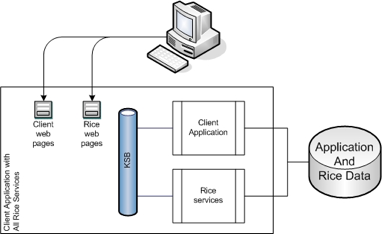Table of Contents
- Rice Client Overview
- Global Configuration Parameters
- Rice Service Architecture and Configuration Overview
- Eclipse and Rice
- Overview
- Download the Tools
- Import rice into Eclipse as a project (Source distribution only)
- Check out the Rice code (Non-source SVN distribution only)
- Set up database drivers
- Set up Eclipse for Maven
- Rebuild Rice
- Install the database
- Installing the appropriate configuration files
- Run the sample web application
- Changing Rice project dependencies
- Other Notes
- Creating Rice Enabled Applications
You can integrate your application with Rice using several methods, each described below.
This method includes embedding some or all of the Rice services into your application. When using this method, a standalone Rice server for the Rice web application is still required to host the GUI screens and some of the core services.
To embed the various Rice modules in your application, you configure them in the RiceConfigurer using Spring. For more details on how to configure the RiceConfigurer for the different modules, please read the Configuration Section in the Technical Resource Guide for the module you want to embed.
Integration of database transactions between client application and embedded Rice (via JTA)
Performance: Embedded services talk directly to the Rice database
No need for application plug-ins on the server
Great for Enterprise deployment: It’s still a single Rice web application, but scalability is increased because there are multiple instances of embedded services.
This method includes the entire Rice web application and all services into your application. This method does not require a standalone Rice server.
Each of the Rice modules provides a set of JSPs and tag libraries that you include in your application. These are then embedded and hooked up as Struts Modules. For more details on how the web portion of each module is configured, please read the Configuration Guide for each of the modules.
All the advantages of Embedded Method
No need to deploy a standalone Rice server
Ideal for development or quick-start applications
May ease development and distribution
Can switch to Embedded Method for deployment in an Enterprise environment
This method utilizes some pre-built classes to provide an interface between your application and web services on a standalone Rice server.
Many of the Rice services are exposed by the KSB as Java service endpoints. This means they use Java Serialization over HTTP to communicate. If desired, they can also be secured to provide access to only those callers with authorized digital signatures.
This means directly using web services to access a standalone Rice server. This method utilizes the same services as the Thin Java Client, but does not take advantage of pre-built binding code to access those services.


